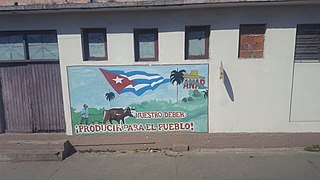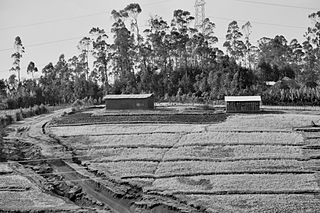
The Soviet Union introduced forced collectivization of its agricultural sector between 1928 and 1940 during the ascension of Joseph Stalin. It began during and was part of the first five-year plan. The policy aimed to integrate individual landholdings and labour into nominally collectively-controlled and openly or directly state-controlled farms: Kolkhozes and Sovkhozes accordingly. The Soviet leadership confidently expected that the replacement of individual peasant farms by collective ones would immediately increase the food supply for the urban population, the supply of raw materials for the processing industry, and agricultural exports via state-imposed quotas on individuals working on collective farms. Planners regarded collectivization as the solution to the crisis of agricultural distribution that had developed from 1927. This problem became more acute as the Soviet Union pressed ahead with its ambitious industrialization program, meaning that more food would be needed to keep up with urban demand.

In East Germany, a Landwirtschaftliche Produktionsgenossenschaft (LPG) was a large, collectivised farm in East Germany, corresponding to the Soviet kolkhoz.
The Stolypin agrarian reforms were a series of changes to Imperial Russia's agricultural sector instituted during the tenure of Prime Minister Pyotr Stolypin. Most, if not all, of these reforms were based on recommendations from a committee known as the "Needs of Agricultural Industry Special Conference," which was held in Russia between 1901 and 1903 during the tenure of Minister of Finance Sergei Witte.

Agriculture in the Soviet Union was mostly collectivized, with some limited cultivation of private plots. It is often viewed as one of the more inefficient sectors of the economy of the Soviet Union. A number of food taxes were introduced in the early Soviet period despite the Decree on Land that immediately followed the October Revolution. The forced collectivization and class war against "kulaks" under Stalinism greatly disrupted farm output in the 1920s and 1930s, contributing to the Soviet famine of 1932–33. A system of state and collective farms, known as sovkhozes and kolkhozes, respectively, placed the rural population in a system intended to be unprecedentedly productive and fair but which turned out to be chronically inefficient and lacking in fairness. Under the administrations of Nikita Khrushchev, Leonid Brezhnev, and Mikhail Gorbachev, many reforms were enacted as attempts to defray the inefficiencies of the Stalinist agricultural system. However, Marxist–Leninist ideology did not allow for any substantial amount of market mechanism to coexist alongside central planning, so the private plot fraction of Soviet agriculture, which was its most productive, remained confined to a limited role. Throughout its later decades the Soviet Union never stopped using substantial portions of the precious metals mined each year in Siberia to pay for grain imports, which has been taken by various authors as an economic indicator showing that the country's agriculture was never as successful as it ought to have been. The real numbers, however, were treated as state secrets at the time, so accurate analysis of the sector's performance was limited outside the USSR and nearly impossible to assemble within its borders. However, Soviet citizens as consumers were familiar with the fact that foods, especially meats, were often noticeably scarce, to the point that not lack of money so much as lack of things to buy with it was the limiting factor in their standard of living.

Agriculture in Russia is an important part of the economy of the Russian Federation. The agricultural sector survived a severe transition decline in the early 1990s as it struggled to transform from a command economy to a market-oriented system. Following the breakup of the Soviet Union in 1991, large collective and state farms – the backbone of Soviet agriculture – had to contend with the sudden loss of state-guaranteed marketing and supply channels and a changing legal environment that created pressure for reorganization and restructuring. In less than ten years, livestock inventories declined by half, pulling down demand for feed grains, and the area planted to grains dropped by 25%.

A UBPC, or Basic Unit of Cooperative Production, are a type of agricultural cooperative that exists in Cuba.
A CPA, or Agricultural Production Cooperative, is a type of agricultural cooperative that exists in Cuba.

The National Association of Small Farmers (ANAP) is a cooperative federation dedicated to promoting the interests of small farmers in Cuba. ANAP has over 300,000 members.
In the Hungarian People's Republic, agricultural collectivization was attempted a number of times in the late 1940s, until it was finally successfully implemented in the early 1960s. By consolidating individual landowning farmers into agricultural co-operatives, the Communist government hoped to increase production and efficiency, and put agriculture under the control of the state.

Tajikistan is a highly agrarian country, with its rural population at more than 70% and agriculture accounting for 60% of employment and around 20% of GDP in 2020. As is typical of economies dependent on agriculture, Tajikistan has a low income per capita: Soviet Tajikistan was the poorest republic with a staggering 45% of its population in the lowest income “septile”. In 2006 Tajikistan still had the lowest income per capita among the Commonwealth of Independent States (CIS) countries: $1,410 compared with nearly $12,000 for Russia. The low income and the high agrarian profile justify and drive the efforts for agricultural reform since 1991 in the hope of improving the population's well-being.

Ernesto "Che" Guevara was an Argentine Marxist revolutionary, physician, author, guerrilla leader, diplomat, and military theorist. A major figure of the Cuban Revolution, his stylized visage has become a ubiquitous countercultural symbol of rebellion and global insignia in popular culture.
Four major land reforms have taken place in Romania: in 1864, 1921, 1945 and 1991. The first sought to undo the feudal structure that had persisted after the unification of the Danubian Principalities in 1859; the second, more drastic reform, tried to resolve lingering peasant discontent and create social harmony after the upheaval of World War I and extensive territorial expansion; the third, imposed by a mainly Communist government, did away with the remaining influence of the landed aristocracy but was itself soon undone by collectivisation, which the fourth then unravelled, leading to almost universal private ownership of land today.

The problem of land reform in Ethiopia has hampered that country's economic development throughout the late 19th and 20th centuries. Attempts to modernize land ownership by giving title either to the peasants who till the soil, or to large-scale farming programs, have been tried under imperial rulers like Emperor Haile Selassie, and under Marxist regimes like the Derg, with mixed results. The present Constitution of Ethiopia, which was put into force January 1995, vests land ownership exclusively "in the State and in the peoples of Ethiopia." The relevant section continues, "Land is a common property of the Nations, Nationalities and Peoples of Ethiopia and shall not be subject to sale or to other means of exchange." Despite these different approaches to land reform, Ethiopia still faces issues of sustainable food self-sufficiency.
The Polish People's Republic pursued a policy of agricultural collectivization throughout the Stalinist regime period, from 1948 until the liberalization during Gomułka's thaw of 1956. However, Poland was the unique country in the Eastern Bloc where large-scale collectivization failed to take root. A legacy of collectivization in Poland was the network of inefficient State Agricultural Farms (PGRs), many of which can still be seen in the countryside of modern Poland, especially in its northern and western provinces.

Like the rest of the economy, agriculture in Estonia has been in great flux since the degeneration of the collective and state farm systems.
Prior to World War II, agriculture in Bulgaria was the leading sector in the Bulgarian economy. In 1939, agriculture contributed 65 percent of Net material product (NMP), and four out of every five Bulgarians were employed in agriculture. The importance and organization of Bulgarian agriculture changed drastically after the war, however. By 1958, the Bulgarian Communist Party (BCP) had collectivized a high percentage of Bulgarian farms; in the next three decades, the state used various forms of organization to improve productivity, but none succeeded. Meanwhile, private plots remained productive and often alleviated agricultural shortages during the Todor Zhivkov era.
Agrarian reform and land reform have been a recurring theme of enormous consequence in world history. They are often highly political and have been achieved in many countries.

Collective farming and communal farming are various types of "agricultural production in which multiple farmers run their holdings as a joint enterprise". There are two broad types of communal farms: agricultural cooperatives, in which member-owners jointly engage in farming activities as a collective; and state farms, which are owned and directly run by a centralized government. The process by which farmland is aggregated is called collectivization. In some countries, there have been both state-run and cooperative-run variants. For example, the Soviet Union had both kolkhozy and sovkhozy.
Agrarian socialism is a political ideology that promotes social ownership of agrarian and agricultural production as opposed to private ownership. Agrarian socialism involves equally distributing agricultural land among collectivized peasant villages. Many agrarian socialist movements have tended to be rural, locally focused, and traditional. Governments and political parties seeking agrarian socialist policies have existed throughout the world, in regions including Europe, Asia, North America, Latin America, and Africa.
Villagization was a land reform and resettlement program in Ethiopia implemented by the Derg in 1985 that aimed to systematize and regulate village life and rural agriculture. Villagization typically involved the relocation of rural communities or nomadic groups to planned villages with communal farmland.











